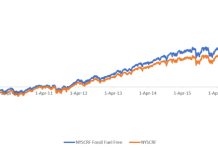Tom Konrad CFA
The unprecedented boom in natural gas supplies over the last few years as been one of the few tail-winds for the US economy over the last few years, as plummeting natural gas prices have lowered costs for both industry and consumers. Few outside the natural gas industry even understood the shear scale of the shale gas resource, although industry insiders did.
The Shale Gas Glut
In 2008, I recall a natural gas executive complaining about how he could not get policymakers to understand the sheer scale of the shale gas resource. To be honest, I did not take his comments seriously, either. That was a mistake. Shale gas has transformed our economy in many ways, and changed the economics of competing fuels, from coal and nuclear to renewables like solar, wind, and geothermal. Cheap natural gas is even doing what Pickens failed to do: get a major oil company to invest in natural gas filling stations.
While shale gas transformed our economy, it also transformed the stock market, which is why I should have paid more attention. Low natural gas prices have not only hurt renewable energy stocks, they have also helped chemical and fertilizer companies that use natural gas as a feedstock. I first came across LSB Industries (NYSE:LXU), a geothermal heat pump (GHP) and chemical company that uses a lot of natural gas a couple month’s after I heard the natural gas executive’s rant. I bought both LXU and its pure-play GHP rival Waterfurnace (TSX:WFI,OTC:WFIFF) at the time, but I sold LXU a few months later, congratulating myself on a quick double at $16, while holding Waterfurnace. Waterfurnace is down a little since I bought it (although it has been paying a nice dividend along the way, while LSB doubled again, in large part because of the tail winds from low natural gas prices.
I don’t plan to make the same mistake again, so I pay more attention to what’s going on with fossil fuels. To that end, I attended the 2012 Symposium on Oil Supply and Demand: Studying the Wildcards, where industry experts tried to predict the next fossil fuel “surprise” that should not be a surprise, if we’d only been paying attention. (The presentations and video proceedings are available at oilwildcards.com.)
NGLs: The Next Shale Gas?
If there is going to be another fossil fuel glut to follow natural gas, it will probably be Natural Gas Liquids (NGLs, not to be confused with Liquefied Natural Gas, or LNG). Natural gas liquids are the slightly larger carbon compounds such as ethane, pentane, and propane, which are co-produced with natural gas, but are usually counted with oil production in industry statistics. But, as I learned at the symposium, NGLs should not really be counted with oil or gas, or even separately. Each NGL has its own uses, and its own market, and they need to be considered separately if we are to understand the price dynamics.
Perhaps most importantly for those of us worried about the ability of oil production to keep up with demand, NGLs are not used as transportation fuel (with a tiny exception for propane in forklifts and the like.) Hence, even though NGLs are often counted as part of the oil supply, they do not ease the constraints on the supply of gas or diesel.
The reason NGLs are interesting now is because recent low natural gas prices have led natural gas producers to dramatically shift drilling away from “lean” prospects (which produce natural gas but few NGLs) to “rich” ones (which produce significant NGLs along with the natural gas.) This trend was highlighted at the Symposium by Adam Bedard, Senior Director at BENTEK Energy, an energy markets analytics company (see graph above). So far, relatively high prices for NGLs have kept many wet gas wells profitable despite low gas prices. In a sense, gas companies are drilling for NGLs, and producing natural gas a a byproduct.
The problem is that the rapid shift towards NGL-rich plays is liable to produce more NGLs than the market can handle. According to George Little, a partner at Groppe, Long & Littell, an oil and gas analysis and forecast provider speaking at the Symposium, the leading indicators of periods of NGL oversupply are the relative prices of olefins ethylene and propylene, which are made from NGLs.
When propylene prices are above ethylene prices, it is a leading indicator for ethane being sold for its heat value into the natural gas market, rather than being sold into the chemicals market. That indicator, according to Little, is currently “flashing red” (see graph above.) The problem with selling ethane into the natural gas markets is that, with current low natural gas prices, it will only fetch $0.10 to $0.16 per gallon, a fraction of the current price.
Competition with natural gas for industrial uses and heating has also been eroding the propane market. The butane market is similarly stagnant.
Stocks to Avoid
With stagnant demand in most NGL markets, it’s no surprise that new supply has been dramatically reducing NGL prices. The coming flood of new supply will only push NGL prices down further. Natural gas producers that are counting on high NGL prices to maintain profitability are likely to find it as hard to profit from NGLs over the next few years as it recently has been to make a profit from natural gas.
Which natural gas producers are most reliant on NGLs, and hence vulnerable to a price collapse? Devon Energy (NYSE: DVN), recently announced a sixth consecutive quarter of increasing NGL production and an 80% year over year increase in NGLs from the Cana Woodford shale. On the other hand, Chesapeake Energy (NYSE:CHK) may be less vulnerable, since that company recently trimmed its projections for NGL production.
On the green side of the coin, biochemical companies which have turned to these higher-margin businesses in order to escape commodity squeezes in biofuels may see the same story repeating itself in chemicals. Investors should not count on high-margin biochemicals to remain high-margin if they replace petrochemicals made from NGLs.
Likely Winners
On the other hand, midstream NGL companies should be able to produce increasing profits from NGL bottlenecks. Pipeline operator ONEOK Partners (NYSE:OKS) and Enterprise Products P
artners (NYSE:EPD) have both been seeing increasing margins from their NGL operations. Those trends are likely to continue as the growing NGL glut increases demand for NGL transportation and processing infrastructure.
Disclosure: Long LXU, WFIFF
This article was first published on the author’s Forbes.com blog, Green Stocks.
DISCLAIMER: Past performance is not a guarantee or a reliable indicator of future results. This article contains the current opinions of the author and such opinions are subject to change without notice. This article has been distributed for informational purposes only. Forecasts, estimates, and certain information contained herein should not be considered as investment advice or a recommendation of any particular security, strategy or investment product. Information contained herein has been obtained from sources believed to be reliable, but not guaranteed.








